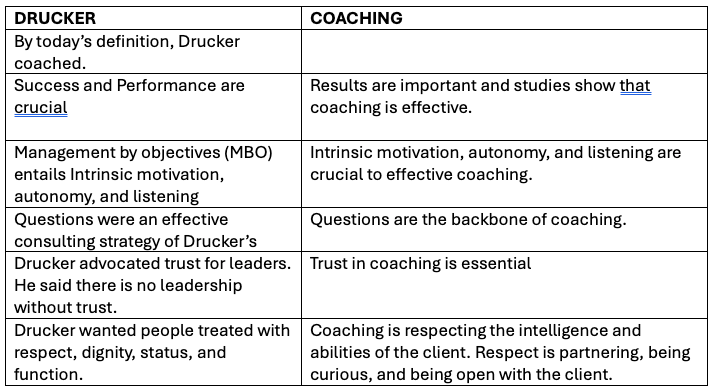Peter F. Drucker’s management philosophy and life coaching are interchangeable
PUBLISHED:
Tell me and I forget. Teach me and I remember. Involve me and I learn.
Benjamin Franklin
Life coaching, including leadership/executive coaching, team coaching, relationship coaching, health and wellness coaching, and others, has been around for about 40 years. The International Coaching Federation (ICF) started in 1995 and is the only international organization that certifies coaching schools and coaches. It is the world’s largest organization of professionally trained business and personal coaches. ICF defines coaching as “partnering with clients in a thought-provoking and creative process that inspires them to maximize their personal and professional potential.” According to the ICF, a coach must develop a mindset that is open, curious, flexible, and client-centered. A coach always acknowledges that clients are responsible for their own choices. (coachingfederation.org). So coaching is a process that focuses on the client and encourages client autonomy and decision-making. This should result in more cognitive clarity, better decision-making, and the client being completely confident in his or her decisions. Platis (2016) states that the coach must listen to the client, even in the case where the client does not know exactly where he or she wants to go.
I earned an Associate Certified Life Coach Credential 4 years ago from an ICF-certified school and recently completed ICF training for an International Coaching Federation Professional Coaching Credential. I was taught that asking the right questions is the main tool of an effective coach. A coach is not a counselor or a therapist and does not make decisions for a client. A coach rarely even gives advice to a client. Potential clients with a psychological condition should be referred to a mental health professional. The beginning of a coaching relationship is when the coach works with the client to create an agreement or contract. This includes what each party agrees to or not to do and, among other things, a pledge of confidentiality. After some trust is established, the coach assumes that the client has the answers to their dilemmas, problems, or difficulties.
Peter Drucker said trust is an essential requirement of effective leaders. Without trust, according to Drucker, leaders have no followers. And to build trust, Drucker challenged leaders to go beyond the singular “I” and to lead from a more empowering “we” (Atkins 2009).
It is the coach’s job to draw those answers out of the client, much like Peter Drucker, the “father of modern management” and notable consultant, did by asking questions. Cohen (2008 p.205) relates the story of Drucker consulting for General Electric CEO Jack Welch. Drucker asked him two questions: If you weren’t already in a business, would you enter it today?” and If not, what are you going to do about it?”. Ultimately, the client should realize that they are making the decisions and have the power and the knowledge to solve life’s problems (coachingfederation.org). Two concepts that were stressed during my coaching schools are: “Don’t be a fixer.” and “Coach the person, not the problem.” In other words, trying to “fix” someone is telling them they are dependent and unable to help themselves. And people, as individuals, can function independently and should be afforded that dignity.
Peter Drucker believed that the economic performance of a company (success) is important, and its social and political roles are equally important; since a company’s power is derived from its ability to allocate resources and manage its behavior (Romar 2014, p.203). The following quotes are from Peter Drucker: “Leaders create spirit” (engagement), and “Leaders care about and have compassion for people.” (Drucker 1954). In many of Drucker’s writings, he discusses wanting individuals to be accorded dignity, function, and status. These are all goals of both leadership and coaching. Drucker, himself, as a highly respected business consultant, often “coached” clients by asking questions of them, prompting them to find their own solutions to their problems (Cohen 2008).
Grant (2003) found that despite its high media profile and growing popularity, there had been no empirical investigations of the impact of life coaching on goal attainment and metacognition. Grant, therefore, conducted a study of twenty graduate students over a 13-week period that concluded, “solution-focused, cognitive-behavioral life coaching can facilitate goal attainment, improve mental health and enhance life experience.” (p.263).
Peter Drucker, in his 1954 book, The Practice of Management, introduced a (radical, for the time) concept he called Management by Objectives (MBO). This was a type of motivation that gave employees in an organization some autonomy in how their job was done. This autonomy or empowerment has since been studied and written about by countless social scientists. Most notably, Daniel Pink, in his book, Drive, finds that autonomy is an important and effective intrinsic motivator, i.e., an employee will perform at a higher level if he or she has a say in how a task is accomplished (Pink 2009). As previously noted, autonomy and intrinsic motivation is also an important part of coaching. According to Csikszentmihalyi and Hooker (2003) shared leadership is an effective intrinsic motivator when applied to Peter Drucker’s concepts of knowledge work and knowledge workers in their creation of innovation.
Drucker (1954) writes that “the purpose of business is to create a customer.” Johnson (2023) argues that intrinsically motivated employees are the way to, “create a customer”. He differentiates between good bosses, who respect employees and gives them autonomy, and bad bosses, who control and command employees. Johnson also quotes Reinhart Bendix (1956); “All authority relations have in common that those in command cannot fully control those who obey.” (p. xiv). Johnson believes that “good bosses” create engaged and intrinsically motivated employees by coaching and listening to employees instead of trying to control them. These employees, among other things, create loyal customers, who increase a company’s success. Swain (2019) reports that, according to Peter Drucker, millennials are primarily motivated by intrinsic rewards.
William Cohen (2008) quotes Peter Drucker: “One did not manage workers; one has to lead them. Leadership demands ethical and effective motivation.” Cohen explains that Drucker rejected the Theory X approach (described by Douglas McGregor (1960) as the “carrot and stick method that was used 150 years ago). He said it was definitely not the way to intrinsically motivate employees. Cohen used his relationship with Drucker to help create a list of factors that are most motivational for workers. The list included being respected, having interesting work, working for people who listen to your ideas about the job, and having a chance to think for yourself, rather than just carry out instructions (Cohen p.221).
CONCLUSION:
Peter Drucker is still very much relevant. The coaching/client relationship is very much like the leader/follower relationship; to be an effective coach or leader, the client, or the follower should be cared for, respected, listened to, and given autonomy. And whether someone is the coach or the leader, positive results (success) are the desired outcome.

CHART 1: Intersections of coaching and Peter Drucker leadership philosophy: Management as a Liberal Art.
REFERENCES:
Atkins, Andy (2009) Trust and Collaboration: A Virtuous Cycle. Management Issues Nov. 16.
2009. https://www.management-issues.com/opinion/5782/trust-and-collaboration-a-
virtuous-circle/
Bendix, Reinhart (1956) Work and Authority in Industry. University of California Press
(coachingfederation.org) Official website of The International Coaching Federation
Cohen, William A. (2008) A Class With Drucker: The Lost Lessons of the World’s Greatest
Management Teacher. AMACON
Csikszentmihalyi, Mihaly and Hooker, Charles 2003 Flow, Creativity, and Shared Leadership:
Rethinking the Motivation and Structuring of Knowledge Work. Chapter 10 in Shared
Leadership: Reframing the Hows and Whys of Leadership, edited by Craig Pearce and Jay
A. Conger. Sage Publications 2003
Drucker, Peter (1954) The Practice of Management, William Heinemann Ltd.
Johnson, J. Richard (2023) What’s New About Quiet Quitting (and What’s Not)? The
Transdisciplinary Journal of Management. February 28, 2023
https://tjm.scholasticahq.com/article/72079-what-s-new-about-quiet-quitting-and-what-s-not
Grant, Anthony M. (2003) The Impact of Life Coaching in Goal Attainment, Metacognition, and
Mental Health. Social Behavior and Mental Health Vol. 31, Iss.3 (pp.253-264) (2003)
McGregor, Douglas (1960) The Human Side of Enterprise. McGraw-Hill
Pink, Daniel (2009) Drive: The Surprising Truth About What Motivates Us. Penguin Group
Platis, Magdalena (2016) Leadership and Life Coaching. Manager. Iss. 24 (2016) pp. 173-179
Swain, Robert W. (2019) What Motivates the Modern Worker? Peter Drucker on Leading Millenials





